Believe it: Qualcomm’s Snapdragon X Elite looks ready to live up to its incredibly lofty promises based on a suite of early benchmarks we saw Qualcomm run late last week. But are AMD and Intel out of the race? Not at all, as the numbers also reveal how both competitors will likely spin their way back into the conversation.
Qualcomm closed out its Snapdragon Technology Summit in Maui by allowing reporters to view, if not actually run, benchmarks across two demo systems with undisclosed Snapdragon X Elite chips inside them. In general, they met claims that Qualcomm executives had made earlier in the show — that Snapdragon X Elite would meet if not significantly exceed its X86 rivals, specifically the Intel 13th-gen Core chips.
Ever since Apple transitioned to its own internally-designed M-series chips, the Arm world has waited for a similar transition within the Windows PC. Earlier Snapdragon chips struggled with performance, with both compatibility issues and the performance penalty of translated code slowing them down.
When Arm bought Nuvia in 2021, we had the first inkling that that might change. Over the three subsequent years, Qualcomm developed what it’s now calling the Oryon CPU, and announced it here at the Snapdragon Technology Summit, with bold claims that it could essentially double the performance of Intel’s 13th-gen Core chips with what it’s calling the Snapdragon X platform, the Snapdragon X Elite chip, and the Oryon CPU core inside it.
To be clear, reporters were not handed a Snapdragon X Elite system to test; these were Qualcomm-selected systems, with preloaded benchmarks running on top of early silicon, and reporters and analysts were allowed to supervise but not handle the systems. Essentially, the test results these benchmarks generated were little different than the benchmark data any vendor provides.
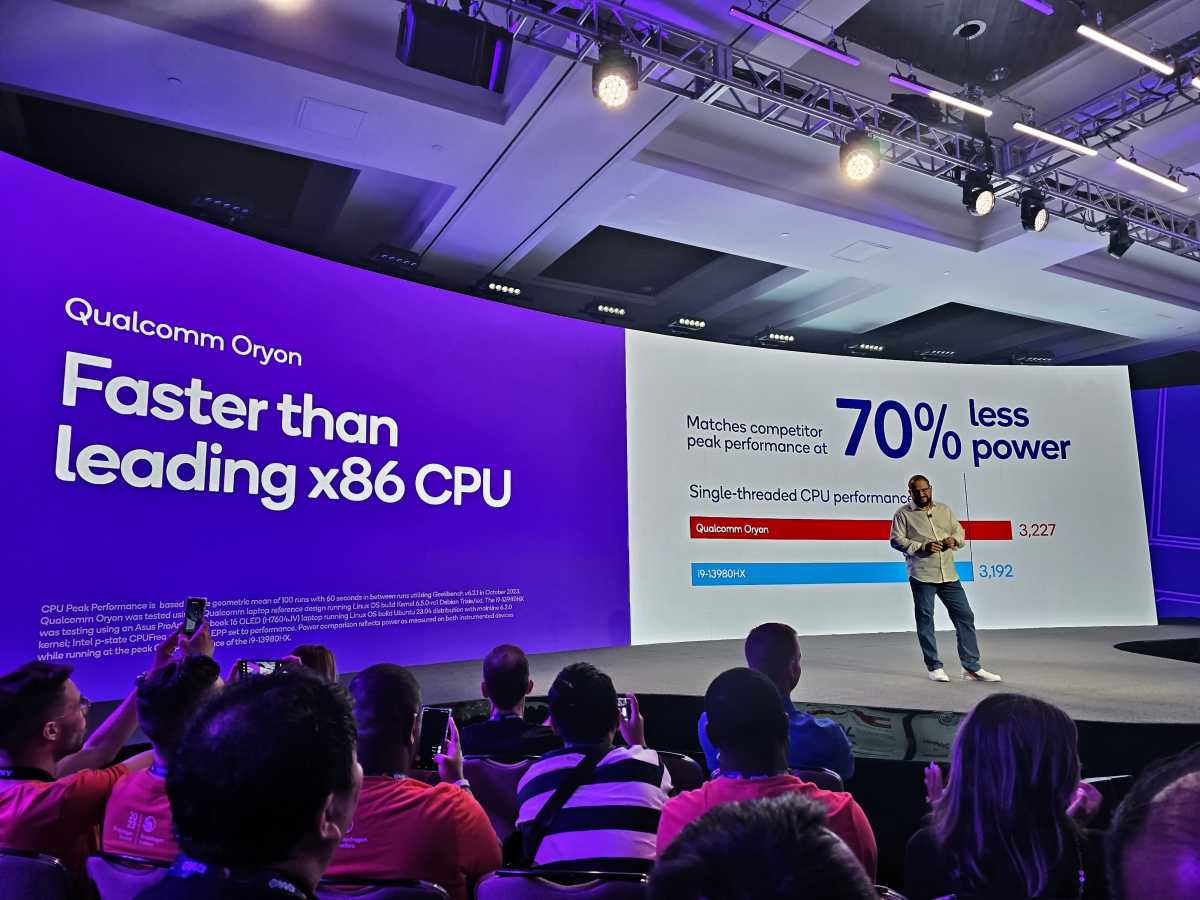
The Qualcomm Snapdragon Oryon is 1 percent faster than an Intel Core i9-13980HX at single-threaded CPU performance.
Mark Hachman / IDG
Qualcomm chief executive Cristiano Amon previously claimed that the Oryon was essentially as fast as a Core i9-13980HK. Qualcomm also said that the Oryon CPU inside the Snapdragon X Elite is up to twice as fast as the Intel Core i7-1355U, roping in Intel’s 12-core chip, the Core i7-1360P, under the same umbrella as well. Qualcomm was a little vague about it all, but the upshot was that the Snapdragon X Elite should offer more performance than either a Core i7-1355U and a Core i7-1360P, with as much performance as the Core i9-13980K in certain scenarios. We’ve delved deeper into the Snapdragon X Elite here.
It’s worth noting that Gerard Williams, the co-founder of Nuvia and the designer or the Snapdragon X Elite’s Oryon CPU, previously designed the Apple M1. So in some sense, Williams is competing against himself.
Qualcomm’s test setup
Qualcomm allowed reporters access to about a dozen reference machines in a pair of configurations: Configuration A had an 80W TDP, with a 3840x2160p display and an 87Wh battery. Configuration B was slightly thinner, with a 23W TDP [Thermal Design Power] and a 2880×1800 OLED display.
Qualcomm said nothing about the specific chip or chips in either. While Intel and AMD design specific chips for specific TDPs, Qualcomm doesn’t. The company believes that its Snapdragon X Elite architecture will scale up its performance as TDPs increase, though the company hasn’t said how far up and down the stack it will go. Remember, too, that each of the twelve Oryon cores are single-threaded, with two cores able to boost to 4.3GHz from the base speed of 3.8GHz.
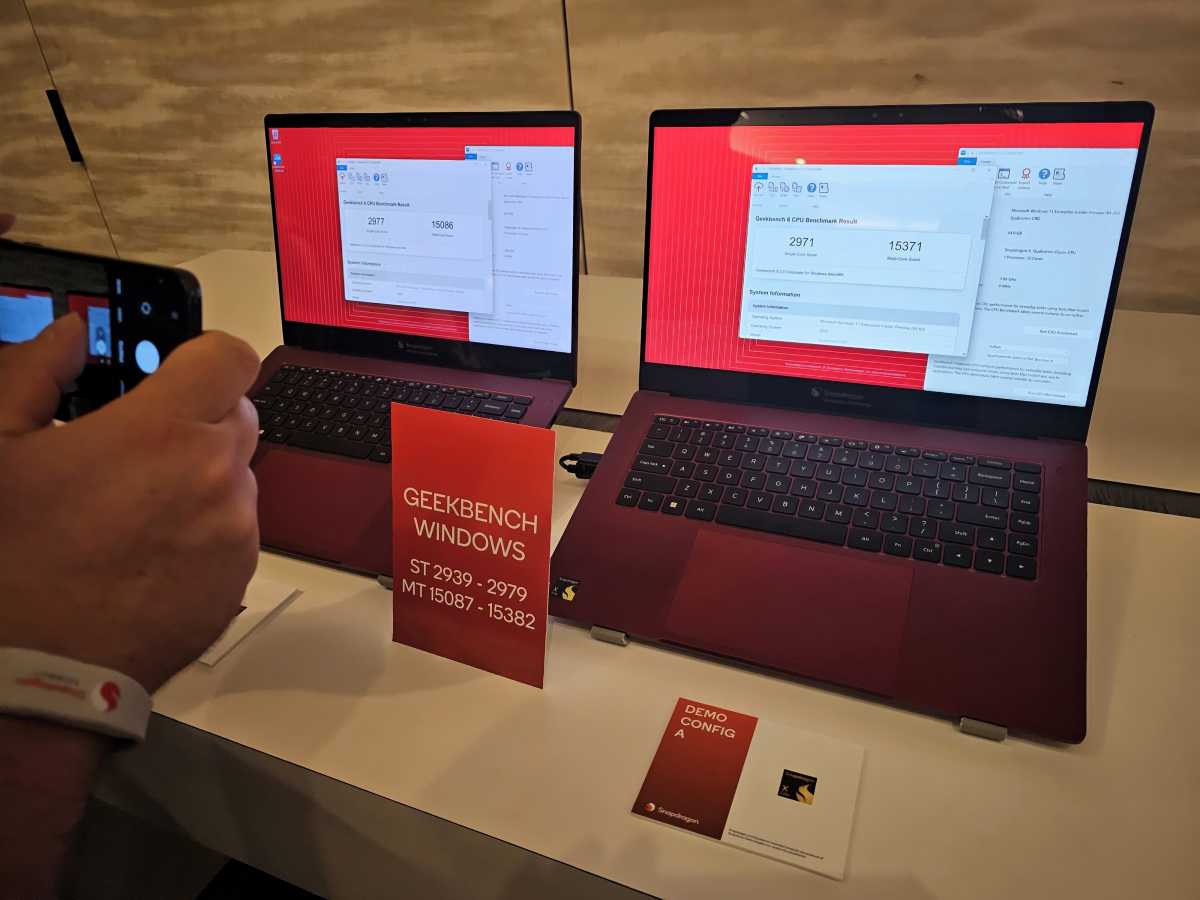
An example of the test setup: look, but don’t touch.
Mark Hachman / IDG
Reporters were not allowed to touch the laptops, perform the tests, or examine the Windows settings menu or other configurations. That means that we can’t say with utter certainty that there wasn’t any hanky-panky going on behind the scenes, but everything appeared aboveboard.
Qualcomm ran several benchmarks, providing both a range of expected scores as well as live tests. The benchmarks included single-threaded and multi-threaded results for Cinebench 2024, the up-to-date CPU benchmark; single- and multi-threaded benchmarks for GeekBench 6, another CPU benchmark; 3DMark’s Wildlife Extreme GPU benchmark; and the GFXBench “Aztec Ruins” benchmark. Qualcomm also chose PCMark 10’s “Apps” benchmark, which test Microsoft Office performance (and because PCMark’s main benchmark doesn’t run under Arm). Finally, Qualcomm selected one of the only “AI” benchmarks available, UL’s Procyon benchmark.
I chose a small selection of notebooks and tablets to compare Qualcomm’s claims to. Because of logistics (travel, timing, and availability) I wasn’t able to select direct competitors in all cases, nor did I have the luxury of running multiple instances of each test. Add that to the fact that these were some of the first silicon out of Qualcomm’s fabs, and it all adds up to a back-of-the-envelope estimate of the chip’s performance — quite telling, but not absolutely definitive.
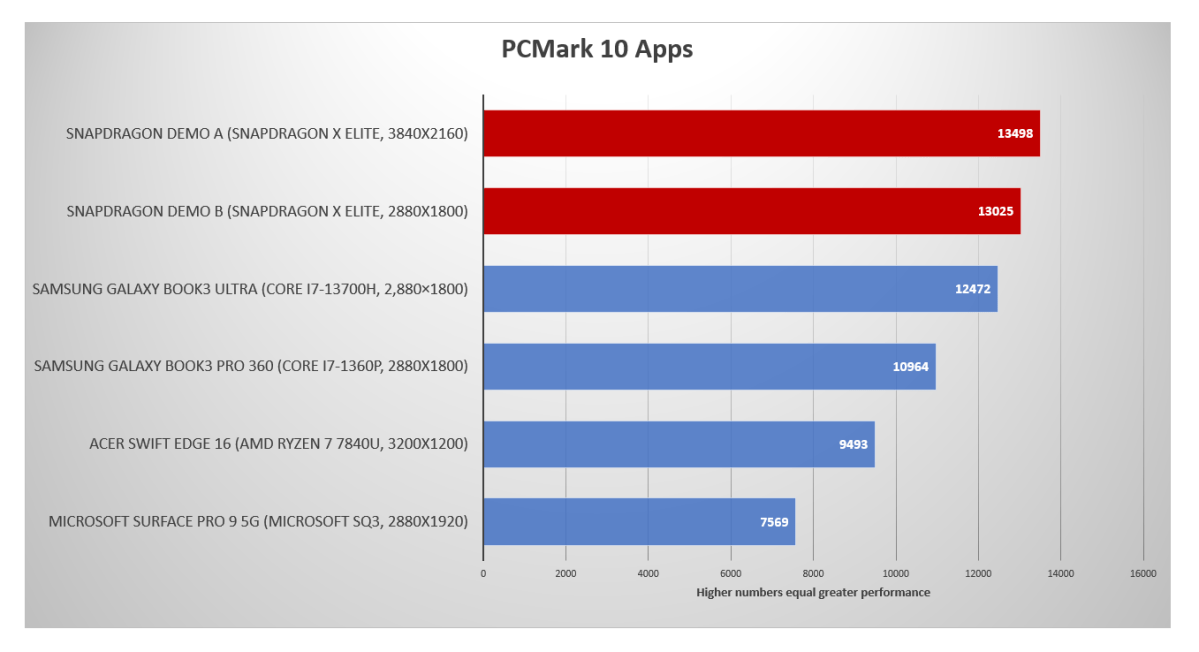
Qualcomm’s Snapdragon X Elite platform promises everyday performance.
Mark Hachman / IDG
For each benchmark, I tested the Samsung Galaxy Book3 Ultra, with a high-end Core i7-13700H. To that, I added the Galaxy Book3 Pro 360, with the Intel Core i7-1360P that Qualcomm cited. The Book3 Pro 360 should have a Movidius NPU attached to it. Interestingly, Windows 11 didn’t report the presence of the NPU – and it didn’t report the NPU for the Acer Swift Edge 16, either. The latter notebook contains the AMD Ryzen 7840U with “available” Ryzen AI, so they should provide some fairly direct competition. They don’t, for now.
Finally, I ran the tests on the Surface Pro 9 (5G), with a Microsoft SQ3 chip inside. That’s a custom derivative of the Qualcomm 8cx Gen 3, the “previous generation” Snapdragon Arm chip, though it’s a different design than the Qualcomm Oryon CPU at the heart of the Snapdragon X Elite.
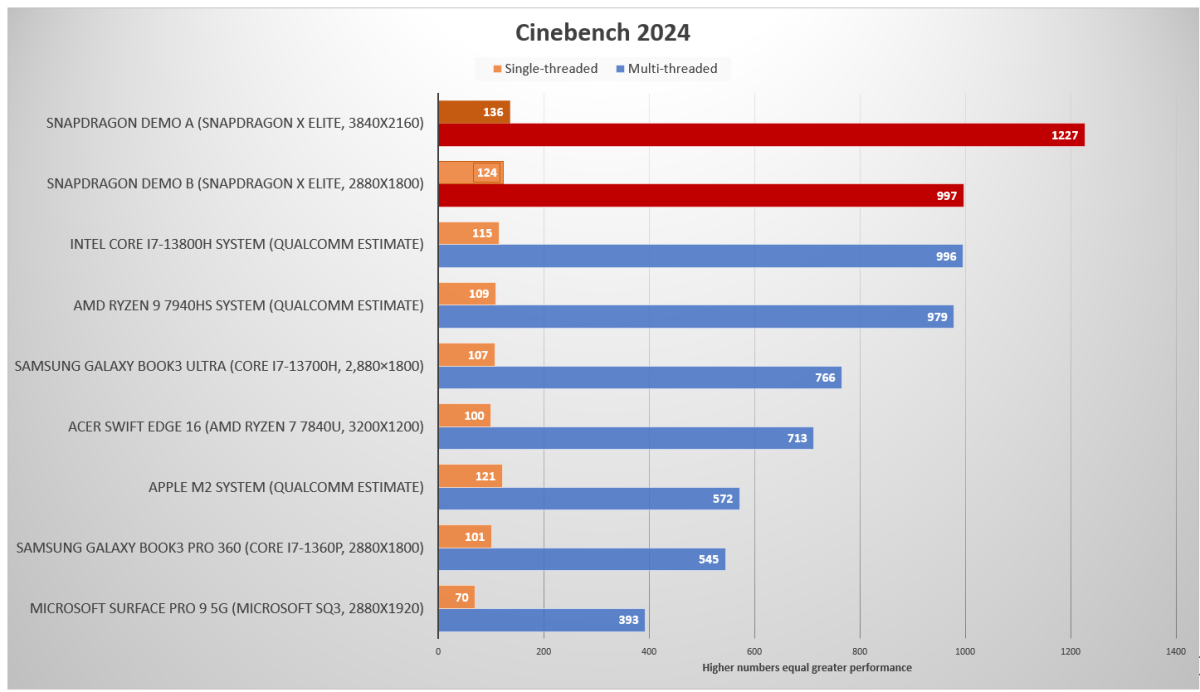
At least on these tests, the Snapdragon X Elite begins blowing away the competition. And yes, that’s about double the performance of the Core 17-1360P.
Mark Hachman / IDG
I’ve included the results in the graphs throughout this section, with further explanation where necessary. In general, I’ve reported the results I saw at the Qualcomm benchmarking session, and the results produced during my own testing. In each graph, however, are results for the Core i7-13800H, Ryzen 9 7940HS, and the Apple M2. Those were all numbers provided by Qualcomm, and we haven’t reproduced them ourselves. We’ve noted that in the charts.
In general, though, Qualcomm’s Snapdragon X Elite platform chewed through the CPU tests we threw at it.
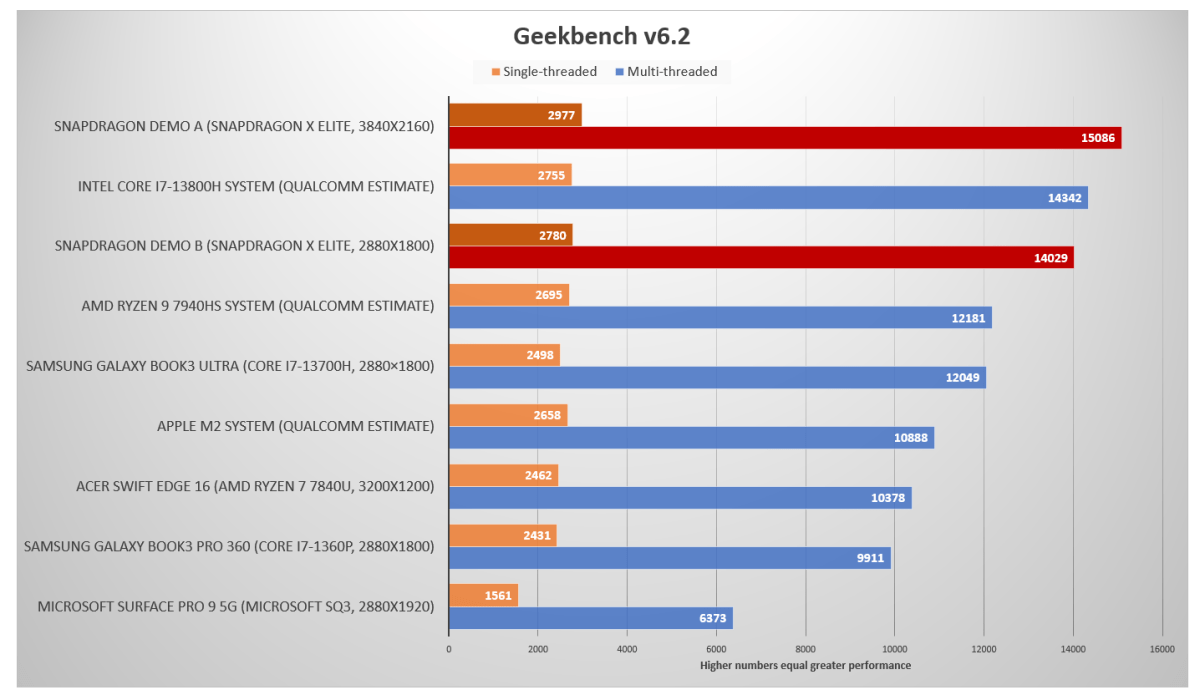
Qualcomm’s Snapdragon X Elite is still at the top of the heap.
Mark Hachman / IDG
I skipped testing the Aztec Ruins benchmark, both for time as well as because I wasn’t quite sure which test Qualcomm used. The company cited a 358 frames per second score on Configuration A, and 299 fps on Configuration B. It claimed that a Core i7-13800H system would generate a score of 177 fps, and a Ryzen9 7940HS system would generate a score of 139 fps.
Qualcomm also stood the 3DMark Wild Life Extreme benchmark on its head. Normally, the benchmark calculates the overall frame rate to generate a score. Qualcomm used the framerates themselves instead.

Qualcomm has not ruled out attaching an external GPU to its Snapdragon X Elite platform.
Mark Hachman / IDG
AI benchmarks hide some interesting details
UL’s Procyon benchmark includes an AI inference benchmark for Windows. (Machine learning trains a model, such as ResNet or Real-ESRGAN; inferencing is feeding it live data and seeing the results. It’s essentially what you do by using an AI model like ChatGPT, except locally, on your PC.) The Procyon benchmark tests the inferencing performance of several models.
The kicker is that some architectures have their own optimized runtime API: Qualcomm has one, called SNPE. Intel has one, too, called OpenVINO; you can also test inferencing on the GPU, with Nvidia’s TensorRT. AMD’s Ryzen architecture is the only one without a tailored API. It’s forced to use Windows ML, which is more of a generic solution — and performance suffers as a result. (It seems likely that AMD will rectify this, probably by December.)
Since the same several inferencing models appear across the various versions of the test, we believe the scores can compare both Arm and X86. Note that you can’t run SNPE, for example, on an X86 PC.
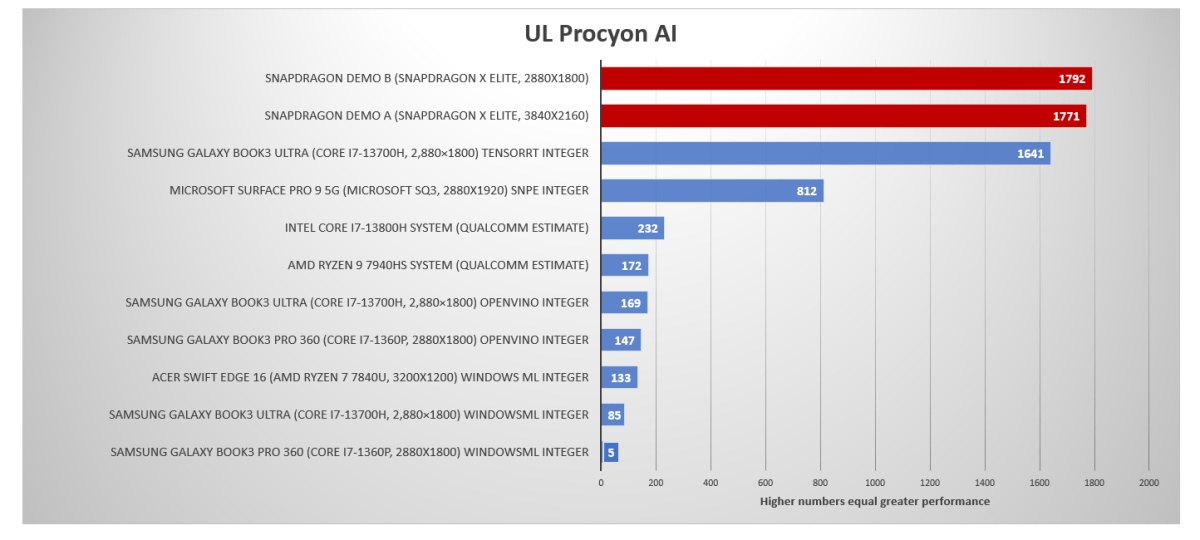
Qualcomm’s NPU is the only one being tested here. And a discrete GPU is a powerful alternative, though not the most cost or power-efficient.
Mark Hachman / IDG
Applying the OpenVINO API to the Galaxy Book3’s Core i7-13700H yielded a score of 169. WindowsML? Just 85. But applying TensorRT allowed the RTX 4050 discrete GPU to kick in — and boosted the score to a whopping 1,641. That puts it right within the range of the Qualcomm NPU found within the Snapdragon X Elite.
That’s a telling point, and one that both AMD and Intel may lean on in the coming months: good GPUs may be able to approximate NPUs. Qualcomm may point to that fact and conclude that users don’t need to shell out for a discrete GPU to get world-beating AI performance. But AMD and Intel may shrug and conclude that those that buy a laptop with a discrete GPUs may get gaming capabilities and world-beating (?) AI capabilities, and with their own NPU to match. After all, Qualcomm’s GPU performance as indicated by the WildLife Extreme benchmark is good, but not great; the company will also launch notebooks as Intel’s Meteor Lake laptops debut, too.
It’s important to remember, too, that we haven’t seen benchmarks on Intel’s Meteor Lake chips yet. Furthermore, the existing Ryzen AI and Movidius NPUs don’t seem to be detected by Procyon yet. That means that AI performance will only increase on competing platforms, especially if they can ask the CPU, GPU, and NPU to all work together.
In years prior, Qualcomm has made its own performance claims, along with estimates of Intel’s performance. In the real world, Qualcomm’s Snapdragons fell well short of Intel’s Core chips. That could happen again with the upcoming Meteor Lake — though with Intel’s conservative performance projections, maybe not.
But that’s the future. Qualcomm has made a bold claim about the Snapdragon X Elite’s own performance, and it seems to bear out so far. Color us impressed.
Editor’s Note: To gain access to Qualcomm’s new Oryon and Snapdragon X Elite platform, Qualcomm offered to pay for PCWorld for room, board and airfare at its Snapdragon Technology Summit. PCWorld accepted, but maintained editorial control of its content.
CPUs and Processors
Qualcomm closed out its Snapdragon Technology Summit in Maui by allowing reporters to view, if not actually run, benchmarks across two demo systems with undisclosed Snapdragon X Elite chips inside them. In general, they met claims that Qualcomm executives had made earlier in the show — that Snapdragon X Elite would meet if not significantly exceed its X86 rivals, specifically the Intel 13th-gen Core chips.
Ever since Apple transitioned to its own internally-designed M-series chips, the Arm world has waited for a similar transition within the Windows PC. Earlier Snapdragon chips struggled with performance, with both compatibility issues and the performance penalty of translated code slowing them down.
When Arm bought Nuvia in 2021, we had the first inkling that that might change. Over the three subsequent years, Qualcomm developed what it’s now calling the Oryon CPU, and announced it here at the Snapdragon Technology Summit, with bold claims that it could essentially double the performance of Intel’s 13th-gen Core chips with what it’s calling the Snapdragon X platform, the Snapdragon X Elite chip, and the Oryon CPU core inside it.
To be clear, reporters were not handed a Snapdragon X Elite system to test; these were Qualcomm-selected systems, with preloaded benchmarks running on top of early silicon, and reporters and analysts were allowed to supervise but not handle the systems. Essentially, the test results these benchmarks generated were little different than the benchmark data any vendor provides.

The Qualcomm Snapdragon Oryon is 1 percent faster than an Intel Core i9-13980HX at single-threaded CPU performance.
Mark Hachman / IDG
Qualcomm chief executive Cristiano Amon previously claimed that the Oryon was essentially as fast as a Core i9-13980HK. Qualcomm also said that the Oryon CPU inside the Snapdragon X Elite is up to twice as fast as the Intel Core i7-1355U, roping in Intel’s 12-core chip, the Core i7-1360P, under the same umbrella as well. Qualcomm was a little vague about it all, but the upshot was that the Snapdragon X Elite should offer more performance than either a Core i7-1355U and a Core i7-1360P, with as much performance as the Core i9-13980K in certain scenarios. We’ve delved deeper into the Snapdragon X Elite here.
It’s worth noting that Gerard Williams, the co-founder of Nuvia and the designer or the Snapdragon X Elite’s Oryon CPU, previously designed the Apple M1. So in some sense, Williams is competing against himself.
Qualcomm’s test setup
Qualcomm allowed reporters access to about a dozen reference machines in a pair of configurations: Configuration A had an 80W TDP, with a 3840x2160p display and an 87Wh battery. Configuration B was slightly thinner, with a 23W TDP [Thermal Design Power] and a 2880×1800 OLED display.
Qualcomm said nothing about the specific chip or chips in either. While Intel and AMD design specific chips for specific TDPs, Qualcomm doesn’t. The company believes that its Snapdragon X Elite architecture will scale up its performance as TDPs increase, though the company hasn’t said how far up and down the stack it will go. Remember, too, that each of the twelve Oryon cores are single-threaded, with two cores able to boost to 4.3GHz from the base speed of 3.8GHz.

An example of the test setup: look, but don’t touch.
Mark Hachman / IDG
Reporters were not allowed to touch the laptops, perform the tests, or examine the Windows settings menu or other configurations. That means that we can’t say with utter certainty that there wasn’t any hanky-panky going on behind the scenes, but everything appeared aboveboard.
Qualcomm ran several benchmarks, providing both a range of expected scores as well as live tests. The benchmarks included single-threaded and multi-threaded results for Cinebench 2024, the up-to-date CPU benchmark; single- and multi-threaded benchmarks for GeekBench 6, another CPU benchmark; 3DMark’s Wildlife Extreme GPU benchmark; and the GFXBench “Aztec Ruins” benchmark. Qualcomm also chose PCMark 10’s “Apps” benchmark, which test Microsoft Office performance (and because PCMark’s main benchmark doesn’t run under Arm). Finally, Qualcomm selected one of the only “AI” benchmarks available, UL’s Procyon benchmark.
I chose a small selection of notebooks and tablets to compare Qualcomm’s claims to. Because of logistics (travel, timing, and availability) I wasn’t able to select direct competitors in all cases, nor did I have the luxury of running multiple instances of each test. Add that to the fact that these were some of the first silicon out of Qualcomm’s fabs, and it all adds up to a back-of-the-envelope estimate of the chip’s performance — quite telling, but not absolutely definitive.

Qualcomm’s Snapdragon X Elite platform promises everyday performance.
Mark Hachman / IDG
For each benchmark, I tested the Samsung Galaxy Book3 Ultra, with a high-end Core i7-13700H. To that, I added the Galaxy Book3 Pro 360, with the Intel Core i7-1360P that Qualcomm cited. The Book3 Pro 360 should have a Movidius NPU attached to it. Interestingly, Windows 11 didn’t report the presence of the NPU – and it didn’t report the NPU for the Acer Swift Edge 16, either. The latter notebook contains the AMD Ryzen 7840U with “available” Ryzen AI, so they should provide some fairly direct competition. They don’t, for now.
Finally, I ran the tests on the Surface Pro 9 (5G), with a Microsoft SQ3 chip inside. That’s a custom derivative of the Qualcomm 8cx Gen 3, the “previous generation” Snapdragon Arm chip, though it’s a different design than the Qualcomm Oryon CPU at the heart of the Snapdragon X Elite.

At least on these tests, the Snapdragon X Elite begins blowing away the competition. And yes, that’s about double the performance of the Core 17-1360P.
Mark Hachman / IDG
I’ve included the results in the graphs throughout this section, with further explanation where necessary. In general, I’ve reported the results I saw at the Qualcomm benchmarking session, and the results produced during my own testing. In each graph, however, are results for the Core i7-13800H, Ryzen 9 7940HS, and the Apple M2. Those were all numbers provided by Qualcomm, and we haven’t reproduced them ourselves. We’ve noted that in the charts.
In general, though, Qualcomm’s Snapdragon X Elite platform chewed through the CPU tests we threw at it.

Qualcomm’s Snapdragon X Elite is still at the top of the heap.
Mark Hachman / IDG
I skipped testing the Aztec Ruins benchmark, both for time as well as because I wasn’t quite sure which test Qualcomm used. The company cited a 358 frames per second score on Configuration A, and 299 fps on Configuration B. It claimed that a Core i7-13800H system would generate a score of 177 fps, and a Ryzen9 7940HS system would generate a score of 139 fps.
Qualcomm also stood the 3DMark Wild Life Extreme benchmark on its head. Normally, the benchmark calculates the overall frame rate to generate a score. Qualcomm used the framerates themselves instead.

Qualcomm has not ruled out attaching an external GPU to its Snapdragon X Elite platform.
Mark Hachman / IDG
AI benchmarks hide some interesting details
UL’s Procyon benchmark includes an AI inference benchmark for Windows. (Machine learning trains a model, such as ResNet or Real-ESRGAN; inferencing is feeding it live data and seeing the results. It’s essentially what you do by using an AI model like ChatGPT, except locally, on your PC.) The Procyon benchmark tests the inferencing performance of several models.
The kicker is that some architectures have their own optimized runtime API: Qualcomm has one, called SNPE. Intel has one, too, called OpenVINO; you can also test inferencing on the GPU, with Nvidia’s TensorRT. AMD’s Ryzen architecture is the only one without a tailored API. It’s forced to use Windows ML, which is more of a generic solution — and performance suffers as a result. (It seems likely that AMD will rectify this, probably by December.)
Since the same several inferencing models appear across the various versions of the test, we believe the scores can compare both Arm and X86. Note that you can’t run SNPE, for example, on an X86 PC.

Qualcomm’s NPU is the only one being tested here. And a discrete GPU is a powerful alternative, though not the most cost or power-efficient.
Mark Hachman / IDG
Applying the OpenVINO API to the Galaxy Book3’s Core i7-13700H yielded a score of 169. WindowsML? Just 85. But applying TensorRT allowed the RTX 4050 discrete GPU to kick in — and boosted the score to a whopping 1,641. That puts it right within the range of the Qualcomm NPU found within the Snapdragon X Elite.
That’s a telling point, and one that both AMD and Intel may lean on in the coming months: good GPUs may be able to approximate NPUs. Qualcomm may point to that fact and conclude that users don’t need to shell out for a discrete GPU to get world-beating AI performance. But AMD and Intel may shrug and conclude that those that buy a laptop with a discrete GPUs may get gaming capabilities and world-beating (?) AI capabilities, and with their own NPU to match. After all, Qualcomm’s GPU performance as indicated by the WildLife Extreme benchmark is good, but not great; the company will also launch notebooks as Intel’s Meteor Lake laptops debut, too.
It’s important to remember, too, that we haven’t seen benchmarks on Intel’s Meteor Lake chips yet. Furthermore, the existing Ryzen AI and Movidius NPUs don’t seem to be detected by Procyon yet. That means that AI performance will only increase on competing platforms, especially if they can ask the CPU, GPU, and NPU to all work together.
In years prior, Qualcomm has made its own performance claims, along with estimates of Intel’s performance. In the real world, Qualcomm’s Snapdragons fell well short of Intel’s Core chips. That could happen again with the upcoming Meteor Lake — though with Intel’s conservative performance projections, maybe not.
But that’s the future. Qualcomm has made a bold claim about the Snapdragon X Elite’s own performance, and it seems to bear out so far. Color us impressed.
Editor’s Note: To gain access to Qualcomm’s new Oryon and Snapdragon X Elite platform, Qualcomm offered to pay for PCWorld for room, board and airfare at its Snapdragon Technology Summit. PCWorld accepted, but maintained editorial control of its content.
CPUs and Processors
